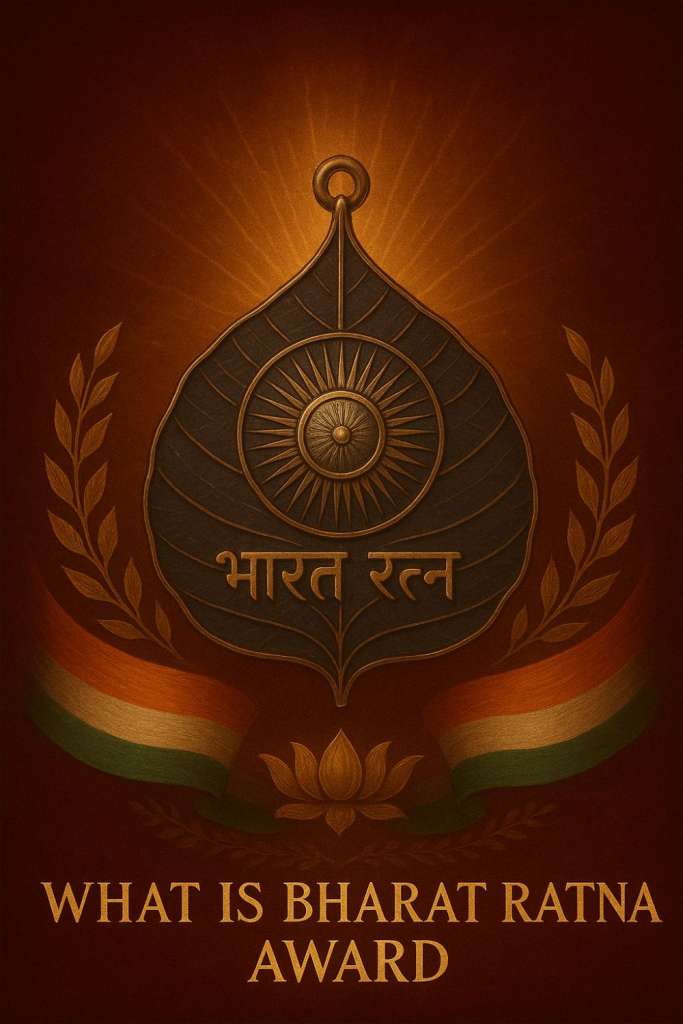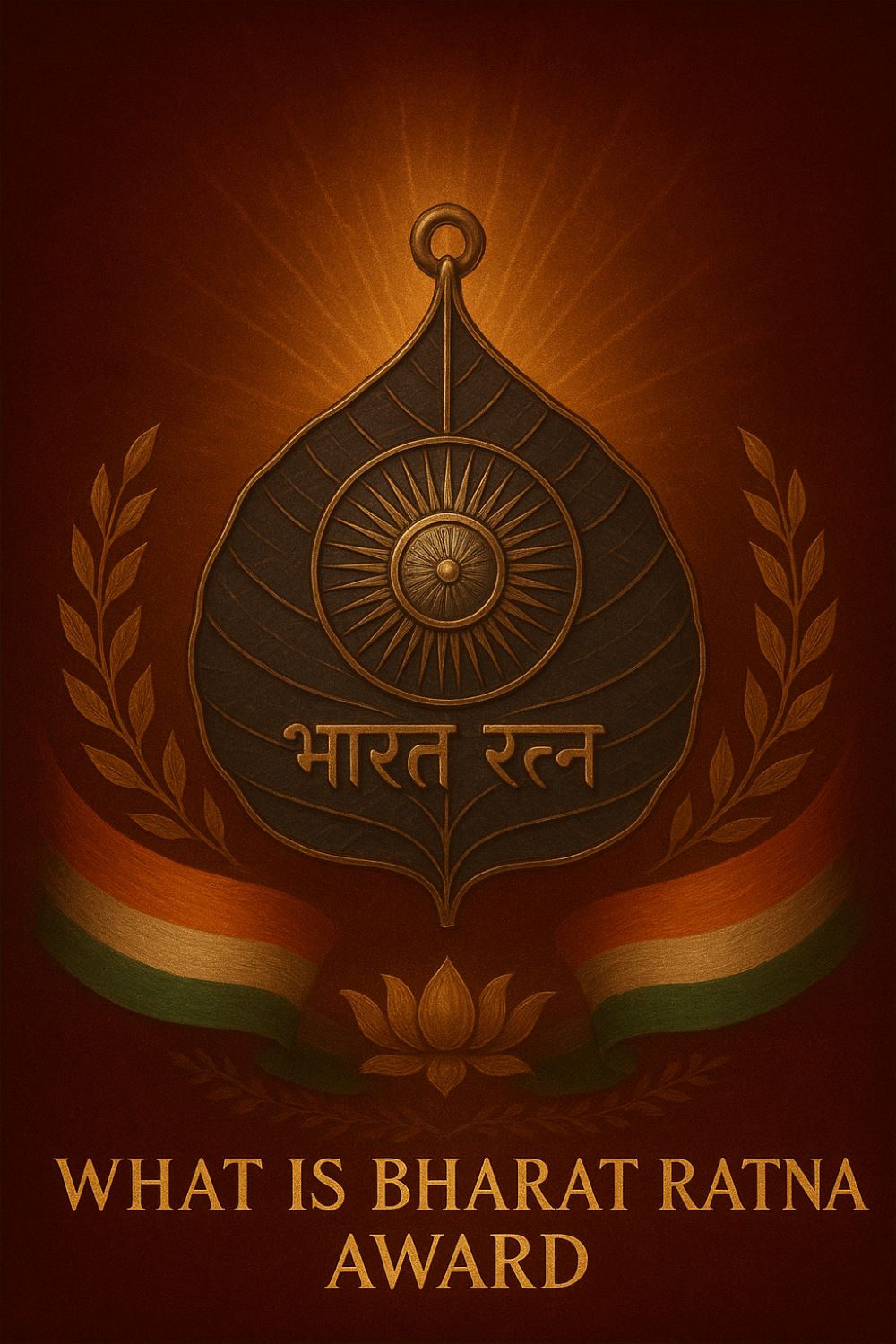India is a land of legends—visionaries, leaders, scientists, artists, and social reformers whose contributions have shaped the nation’s identity. To honor such unparalleled service and extraordinary achievements, the Government of India confers the Bharat Ratna Award, the country’s highest civilian award.
First instituted in 1954, the Bharat Ratna recognizes individuals who have made exceptional contributions in fields such as art, literature, science, public service, and sports. Over the years, it has become not just a medal of honor, but a symbol of India’s gratitude towards its greatest contributors.
In this blog, we will dive deep into what the Bharat Ratna is, its history, eligibility criteria, selection process, notable awardees, controversies, and why it holds such unmatched prestige.
Table of Contents

What is the Bharat Ratna Award?
The Bharat Ratna literally translates to “Jewel of India.” It is India’s highest civilian honor, awarded for “exceptional service or performance of the highest order” in any field of human endeavor.
Unlike many awards that focus on specific areas (like Padma awards for arts, literature, or science), the Bharat Ratna recognizes extraordinary service in any field, including contributions to national development, social welfare, and international goodwill.
It is awarded without distinction of race, occupation, position, or sex. Both Indian citizens and non-Indians have received this honor for their contribution to humanity and society.
The Bharat Ratna remains India’s most prestigious honor.
👉 Also check out our blog on Padma Awards – India’s Second-Highest Civilian Honors to understand how these recognitions differ.
History of Bharat Ratna Award
The Bharat Ratna was instituted in 1954 by then-President Dr. Rajendra Prasad, under the recommendation of Prime Minister Jawaharlal Nehru.
The first recipients in 1954 were:
- Dr. Sarvepalli Radhakrishnan (Philosopher & 2nd President of India)
- C. Rajagopalachari (Last Governor-General of India, statesman)
- C.V. Raman (Nobel laureate physicist)
Since then, over 50 personalities have been honored, covering diverse fields like politics, science, arts, literature, sports, and social service.
Initially, the award was restricted to contributions in arts, literature, science, and public service, but in 2011, the criteria were expanded to include any field of human endeavor.
Design and Symbolism of the Bharat Ratna Medal
The Bharat Ratna medal is a peepal leaf-shaped medallion, about 5.8 cm long, 4.7 cm wide, and 3.1 mm thick.
- The front side carries the sunburst design with the words “Bharat Ratna” inscribed in Hindi.
- The reverse side carries the State Emblem of India and the national motto “Satyameva Jayate.”
- It is made of bronze and worn around the neck with a white ribbon.
Unlike military or gallantry awards, the Bharat Ratna does not carry any monetary grant but holds the highest symbolic honor in India.
Eligibility Criteria for Bharat Ratna
One of the unique aspects of the Bharat Ratna is its broad eligibility:
✅ Awarded for “exceptional service of the highest order” in any field of human endeavor.
✅ No distinction of race, gender, profession, or position.
✅ Both Indians and foreigners can be recipients.
Key Facts:
- Maximum 3 awards can be given in a year.
- Posthumous awards were originally not allowed but have been given since 1955.
- Recommendations are made only by the Prime Minister to the President of India.
Selection Process of Bharat Ratna
The selection process is unique because nominations cannot be made by the public.
- The Prime Minister of India personally recommends the names.
- The list is sent to the President of India for approval.
- Once approved, the announcement is made in the Gazette of India.
This ensures that the award remains exclusive, non-political, and of the highest credibility (though debates and controversies sometimes arise).
Notable Bharat Ratna Recipients
Over the decades, several eminent personalities have been awarded the Bharat Ratna. Let’s look at some of the most inspiring recipients:
Political Leaders
- Jawaharlal Nehru (1955): India’s first Prime Minister.
- Sardar Vallabhbhai Patel (1991, posthumous): Iron Man of India, known for uniting princely states.
- Atal Bihari Vajpayee (2015): Former PM, poet, and statesman.
- Lal Bahadur Shastri (1966, posthumous): Known for the slogan Jai Jawan Jai Kisan.
Social Reformers & Spiritual Leaders
- Mother Teresa (1980): Missionary known for humanitarian work.
- Vinoba Bhave (1983): Spiritual leader and founder of the Bhoodan movement.
- M. S. Subbulakshmi (1998): Carnatic singer, first musician to receive the award.
Scientists & Innovators
- C.V. Raman (1954): Nobel laureate in physics.
- A.P.J. Abdul Kalam (1997): Scientist, missile man, and former President.
- C.N.R. Rao (2014): Renowned chemist.
Sports Personalities
- Sachin Tendulkar (2014): First sportsperson to receive Bharat Ratna.
- Dhyan Chand (2021, posthumous): Legendary hockey player.
Controversies Around Bharat Ratna
While prestigious, the Bharat Ratna has also faced controversies:
- Political Bias Allegations: Some claim selections are politically motivated.
- Demand for Specific Individuals: Public debates often arise demanding the award for personalities like Netaji Subhas Chandra Bose, Bhagat Singh, or Veer Savarkar.
- Sports Inclusion: When Sachin Tendulkar was awarded in 2014, debates arose over why Dhyan Chand wasn’t honored earlier (he was later awarded posthumously in 2021).
Despite these debates, the Bharat Ratna remains a symbol of the nation’s highest respect.
Importance & Significance of Bharat Ratna
The Bharat Ratna is not just an award—it is a national salute to greatness.
- Recognizes extraordinary contributions that shaped India’s history and future.
- Inspires new generations to contribute selflessly to society.
- Enhances India’s global reputation by honoring contributors to human progress.
- Serves as a unifying symbol, celebrating diversity of achievements in politics, science, arts, sports, and social work.
List of Bharat Ratna Awardees (1954–2023)
As of now, 50+ individuals have received the award. A few prominent years:
- 1954: Dr. Sarvepalli Radhakrishnan, C. Rajagopalachari, C.V. Raman
- 1992: Subhas Chandra Bose (controversial, posthumous, withdrawn due to legal issues)
- 2015: Atal Bihari Vajpayee, Madan Mohan Malaviya (posthumous)
- 2019: Pranab Mukherjee, Bhupen Hazarika, Nanaji Deshmukh
- 2021: Dhyan Chand (Hockey legend)
FAQs About Bharat Ratna
1. Who gives the Bharat Ratna?
The President of India presents the award on the recommendation of the Prime Minister.
2. Can Bharat Ratna be awarded posthumously?
Yes, since 1955, several personalities like Lal Bahadur Shastri, Sardar Patel, and Dhyan Chand have received it posthumously.
3. Does the Bharat Ratna come with money?
No, it is a symbolic honor, without monetary benefits. However, recipients enjoy protocol ranking equivalent to Cabinet Ministers.
4. Who was the first woman to receive the Bharat Ratna?
Indira Gandhi (1971), followed by Mother Teresa (1980).
5. Who was the youngest recipient?
Sachin Tendulkar (2014), at the age of 40.
Conclusion
The Bharat Ratna Award is more than a medal—it is India’s highest tribute to greatness, sacrifice, and innovation. It celebrates individuals who have transformed society, uplifted humanity, and brought pride to the nation.
From political leaders like Sardar Patel to scientists like A.P.J. Abdul Kalam, from spiritual icons like Mother Teresa to sports legends like Sachin Tendulkar, the Bharat Ratna represents the soul of India’s excellence.
As India continues its journey of growth, the Bharat Ratna will remain a beacon—reminding us that true greatness lies in service, innovation, and humanity.


